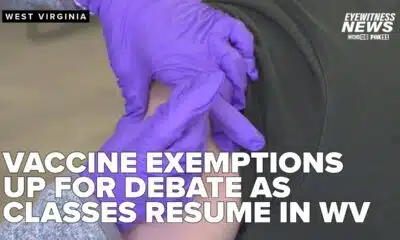Kaiser Health News
Records Show Publix Opioid Sales Grew Even as Addiction Crisis Prompted Other Chains’ Pullback
Ian Hodgson, Tampa Bay Times and Christopher O’Donnell, Tampa Bay Times
Mon, 29 Jan 2024 10:00:00 +0000
An executive at Teva Pharmaceuticals flagged Publix Super Markets in October 2015 after detecting what he called in an email “serious red flags” with the grocery chain’s orders of powerful opioids.
The share of high-strength oxycodone orders was well above normal for a chain of grocery store pharmacies, and the total number of pills sent to Publix stores was “significantly above their peers,” Teva’s head of federal compliance wrote in the email to his supervisors, according to court records in a federal lawsuit pending in Ohio against Publix and other companies.
“This is high-strength oxycodone ultimately going to Florida, a well-established hot spot for oxycodone abuse in the U.S.,” wrote the compliance officer, Joseph Tomkiewicz, in the email explaining why he halted Teva-manufactured prescription opioids to Florida’s Publix pharmacies.
The volume of prescription opioids dispensed in Florida fell 56% from 2011 to 2019 as the pharmaceutical industry was hit by lawsuits for its role in the national opioid crisis, according to a Tampa Bay Times analysis of Drug Enforcement Administration data recently released by a federal court. But while national pharmacy chains like CVS and Walgreens were dispensing fewer of the highly addictive drugs, Publix’s sales were soaring.
The Lakeland-based grocer’s sales of oxycodone climbed from 26 million pills per year in 2011 to 43.5 million in 2019, the data shows. The increase in sales, which far outpaced the chain’s addition of stores in Florida, saw its market share rise to 14%, enough to overtake CVS to become Florida’s second-largest dispenser of all opioid medications, behind only Walgreens, which dispensed 28% of opioids in the state in 2019. The analysis excludes drugs like methadone prescribed for addiction treatment. Opioid sales at Publix dipped slightly in 2018 and 2019, the last two years of available data.
Even as its market share grew, however, Publix was not among the 15 national manufacturers, distributors, and pharmacies that Florida sued in 2018. That lawsuit claimed other pharmacies had flooded America with painkillers such as OxyContin, fueling debilitating addictions that strained communities’ first responders and medical providers.
The state’s lawsuit was a boon for Florida. While admitting to no wrongdoing, the companies agreed to settlement payments to the state, including $177 million from Teva, $440 million from CVS, and $620 million from Walgreens. The state didn’t sue Walmart but in 2022 negotiated a $215 million settlement from the retail giant, which also denied any wrongdoing.
However, there is no mention of Publix’s role on a state webpage touting the 10 opioid settlements reached during Ashley Moody’s tenure as attorney general.
That’s despite Publix being the third-biggest dispenser of opioids in the state, selling nearly twice the amount of the drugs as Walmart from 2006 to 2012, according to earlier DEA data made public in July 2019, more than two years before Florida prosecutors reached settlements with other pharmacy chains.
Moody, a Republican, took over as the state’s top legal official in January 2019. Her office declined to specifically address why Florida has not included Publix in any of its legal actions over opioids.
“We are proud of the more than $3 billion recovered through the historic opioid litigation, and since the filing of the amended complaint, the Department of Legal Affairs has and will continue to take action when merited by the evidence — as we did in the more recent actions with Walmart and McKinsey,” said Moody’s communications director, Kylie Mason, in an email.
The grocery chain made $10.6 million in political donations in Florida from 2016 to 2022 when the state was preparing and pursuing its litigation, state election data shows. Most of the donations were for Republican committees and candidates, including $125,000 donated to the Friends of Ashley Moody political action committee.
In Florida, Walgreens made $637,000 in political donations, including $8,000 to Moody, over the same period. CVS made $208,500 in donations, none of which went to Moody.
Other local communities in Florida and beyond did sue Publix. The federal suit naming Publix that prompted the release of the federal data was filed by Georgia’s Cobb County. It has been earmarked as a test case for dozens of other lawsuits brought by cities and counties in the Southeast. Those include more than 20 Florida communities, among them St. Petersburg and Pinellas and Pasco counties.
While Walgreens and other national companies paid billions to settle their lawsuits and agreed to stricter drug controls, Publix is still contesting the cases.
Those communities claim that the grocery chain failed to operate an “effective suspicious ordering monitoring program” and that when Publix did limit orders to its own pharmacies, those pharmacies could bypass the check by going to a third-party distributor such as AmerisourceBergen.
Publix also should have known that its pharmacies in Georgia, Florida, Alabama, Tennessee, and South Carolina, were filling multiple prescriptions written for the same patient by the same doctor or by multiple doctors, the federal lawsuit alleges. As part of the national opioid settlement, other pharmacy chains were required to be more compliant with laws regulating opioids, including checks on suspicious orders and prescriptions from “blocked and potentially problematic” doctors.
“It’s a heck of a lot cheaper to distribute and dispense controlled substances without all these checks,” said Jayne Conroy, an attorney with New York law firm Simmons Hanly Conroy who is representing the Florida communities and has served as co-lead counsel in the national opioid litigation that has secured more than $50 billion in settlements and verdicts.
Publix did not respond to three emails and three phone calls to its communications office seeking comment.
In its responses to the lawsuits, it has repeatedly denied allegations of wrongdoing.
In seeking to get the Ohio case dismissed, Publix attorneys argued that it can’t be considered “a public nuisance” to legally distribute and dispense opioids. The judge in the case denied the company’s motion and another legal brief that sought to prevent the release of the more recent DEA data.
In November 2022, Publix sued more than a dozen of its insurers in federal court in Tampa, claiming they had not honored policies that would protect it from opioid litigation claims.
It also countersued Cobb County in 2023, saying the Georgia community’s lawsuit was “motivated by promises of a windfall.” The case is still pending.
“Publix takes great pride in its relationship with its valued customers and the communities it serves,” that lawsuit states. “These novel and unprecedented claims are baseless, false, and belied by Publix’s decades of service.”
DEA officials declined to comment on Publix’s opioid record. No enforcement actions against Publix are listed in the federal registry.
A Growing Player
Since its 1930 start as a food store in Winter Haven, Florida, Publix has grown into a massive company with more than 250,000 employees and nearly 900 stores in Florida alone. Revered for its free cookies for kids, chicken tender subs, fresh produce, birthday cakes, and BOGO deals, the grocery chain has become one-stop shopping for customers.
And, increasingly, “Where Shopping Is a Pleasure” — Publix’s slogan since 1954 — includes powerful prescription drugs.
Publix was a smaller player in Florida’s opioid market before 2011, responsible for fewer than 5% of all opioid medications distributed to pharmacies across the state, according to the Times analysis of federal opioid data.
That year marked a turning point for opioid sales in Florida. As the scale of the opioid epidemic came to public attention, and litigation followed, most chain pharmacies began to back off their orders for pills, the data shows.
Many companies ultimately agreed to pay billions of dollars to settle lawsuits filed across the country by state and local governments. That included a $683 million settlement between Florida and Walgreens in May stating the pharmacy, which denied any wrongdoing, must pay for community treatment, education, and prevention programs, plus litigation costs.
In addition to hefty payouts, some settlement agreements required companies to adopt stricter controls to bring operations into fuller compliance with the Controlled Substances Act, a federal law that governs the manufacture, distribution, and use of drugs considered to have a high risk of being abused.
Distributors were required to adopt automated software that would flag suspicious orders from pharmacies such as quantities well above a store’s average. Pharmacy companies were required to conduct checks on doctors to ensure the prescribers are registered with the Drug Enforcement Administration.
Those measures and others put the brakes on opioid distribution nationwide. Meanwhile, the distribution in Florida’s Publix stores went in the opposite direction: From 2011 to 2019, the grocery chain increased its dispensing of all opioid medication by 35%, according to the Times’ analysis of the data.
That growth far exceeded any increase in sales that would correspond to the grocer’s net addition of 146 pharmacies from 2011 to 2019.
As Publix’s distribution increased, so too did the number of orders that should have been flagged as suspicious, according to plaintiffs in multiple lawsuits. Drug distributor McKesson instructed its employees to investigate any pharmacy ordering more than 8,000 oxycodone pills in a single month as part of the company’s “Lifestyle Drug Monitoring Program,” according to 2018 congressional testimony.
Publix pharmacies’ orders surpassed that threshold almost 1,500 times in 2019, the Times analysis found, more than triple the number in 2011. The benchmark has been repeatedly used in opioid litigation as evidence of inadequate monitoring of drug distribution.
‘Red Flags’ Missed
As Tomkiewicz faced pressure from Teva management to fulfill Publix’s orders, he mined the data to back up his concerns, court records show. During a heated phone call, one Teva executive stressed that Publix was an increasingly important player in the opioid distribution market, Tomkiewicz said at his deposition, and an important client for the world’s largest generic drug manufacturer.
Tomkiewicz requested data from Publix’s 10 largest pharmacies by opioid sales, all located in Florida.
By law, Publix was required to keep tabs on the physicians whose prescriptions it filled. But it took Tomkiewicz just one day of searching the internet to find problems, according to time stamps on emails submitted in the court records.
Among the top prescribers at two Publix locations in Melbourne was Thomas Velleff, according to Tomkiewicz’s email. Public records and a newspaper report showed “significant anecdotal evidence of pill mill activity,” Tomkiewicz wrote. He said he found a 2010 article in the Treasure Coast Palm, in which a city employee claimed Velleff’s prior pain clinic in Palm City attracted “carloads” of patients, often with out-of-state license plates.
Complaints filed with the state Department of Health dating to 2010 allege that Velleff overprescribed opioids and failed to monitor his patients’ usage for signs of abuse. One 2017 complaint alleges that Velleff pressured one patient into loaning him money. The state Board of Medicine revoked Velleff’s medical license in December 2020. Velleff did not appear at his medical board hearing, according to the final order revoking his license. He did not respond to emails seeking comment.
A top prescriber at one Ocala store had been disciplined in 2011 for injecting herself with a sedative while leaving an anesthetized patient unsupervised. Other pharmacies repeatedly filled prescriptions from “cash-only” pain clinics or written by physicians located hundreds of miles away with no license to practice in Florida, Tomkiewicz wrote in the email. It is legal to do so, but drug diversion experts consider out-of-state prescriptions a red flag that should prompt additional checks for possible drug abuse.
Tomkiewicz had amassed a list of nine doctors among Publix’s top prescribers who made him wonder: “Why the hell do they still have a license and are still registered with the DEA?” according to his deposition.
Tomkiewicz also said in his deposition he was troubled by not just the volume of opioids Publix was selling, but that they were handing out a disproportionate share of 30-milligram instant-release oxycodone pills — another red flag for abuse. In an email to Teva’s director of compliance, he compared that with the Moffitt Cancer Center in Tampa, where cancer patients were mostly being prescribed 5 mg instant-release pills, court records show.
As the strongest dose on the market, the 30 mg pills have limited use in retail pharmacies and are highly sought-after among abusers, Tomkiewicz wrote in the email. Stronger doses of oxycodone are available, but only in long-release capsules such as OxyContin, according to the U.S. National Institutes of Health.
Publix sold 4.8 million of the highly addictive high-dose pills in 2019 — roughly 1 in 10 of all oxycodone pills dispensed by the pharmacy chain that year, according to the Times analysis of the federal data.
Eventually, Tomkiewicz relented, he said in his deposition. As long as Publix promised not to send Teva products to nine locations that he’d picked out, he would let the shipment go ahead. Teva did not notify federal authorities, according to his deposition.
A Times review of court documents found no written record indicating that Publix responded to Tomkiewicz’s concerns at the time. An expert report submitted in the lawsuit came to the same conclusion.
Tampa Bay Times staff writer Ian Hodgson previously worked for a research company, Cornerstone Research, that had a client relationship with Teva Pharmaceuticals. This article was produced in partnership with the Tampa Bay Times.
Methodology
For comparison and dosing purposes, it is standard practice to convert opioid medications to an equivalent dose of morphine. Every shipment of opioids in the federal database is reported as both the number of pills and its morphine milligram equivalent, or “MME.” This story uses that standard to calculate increases in the number of pills dispensed and compare the volume of pills prescribed by different pharmacy chains.
——————————
By: Ian Hodgson, Tampa Bay Times and Christopher O’Donnell, Tampa Bay Times
Title: Records Show Publix Opioid Sales Grew Even as Addiction Crisis Prompted Other Chains’ Pullback
Sourced From: kffhealthnews.org/news/article/tampa-bay-publix-pharmacy-opioids-crisis/
Published Date: Mon, 29 Jan 2024 10:00:00 +0000
Kaiser Health News
How To Find the Right Medical Rehab Services
Rehabilitation therapy can be a godsend after hospitalization for a stroke, a fall, an accident, a joint replacement, a severe burn, or a spinal cord injury, among other conditions. Physical, occupational, and speech therapy are offered in a variety of settings, including at hospitals, nursing homes, clinics, and at home. It’s crucial to identify a high-quality, safe option with professionals experienced in treating your condition.
What kinds of rehab therapy might I need?
Physical therapy helps patients improve their strength, stability, and movement and reduce pain, usually through targeted exercises. Some physical therapists specialize in neurological, cardiovascular, or orthopedic issues. There are also geriatric and pediatric specialists. Occupational therapy focuses on specific activities (referred to as “occupations”), often ones that require fine motor skills, like brushing teeth, cutting food with a knife, and getting dressed. Speech and language therapy help people communicate. Some patients may need respiratory therapy if they have trouble breathing or need to be weaned from a ventilator.
Will insurance cover rehab?
Medicare, health insurers, workers’ compensation, and Medicaid plans in some states cover rehab therapy, but plans may refuse to pay for certain settings and may limit the amount of therapy you receive. Some insurers may require preauthorization, and some may terminate coverage if you’re not improving. Private insurers often place annual limits on outpatient therapy. Traditional Medicare is generally the least restrictive, while private Medicare Advantage plans may monitor progress closely and limit where patients can obtain therapy.
Should I seek inpatient rehabilitation?
Patients who still need nursing or a doctor’s care but can tolerate three hours of therapy five days a week may qualify for admission to a specialized rehab hospital or to a unit within a general hospital. Patients usually need at least two of the main types of rehab therapy: physical, occupational, or speech. Stays average around 12 days.
How do I choose?
Look for a place that is skilled in treating people with your diagnosis; many inpatient hospitals list specialties on their websites. People with complex or severe medical conditions may want a rehab hospital connected to an academic medical center at the vanguard of new treatments, even if it’s a plane ride away.
“You’ll see youngish patients with these life-changing, fairly catastrophic injuries,” like spinal cord damage, travel to another state for treatment, said Cheri Blauwet, chief medical officer of Spaulding Rehabilitation in Boston, one of 15 hospitals the federal government has praised for cutting-edge work.
But there are advantages in selecting a hospital close to family and friends who can help after you are discharged. Therapists can help train at-home caregivers.
How do I find rehab hospitals?
The discharge planner or caseworker at the acute care hospital should provide options. You can search for inpatient rehabilitation facilities by location or name through Medicare’s Care Compare website. There you can see how many patients the rehab hospital has treated with your condition — the more the better. You can search by specialty through the American Medical Rehabilitation Providers Association, a trade group that lists its members.
Find out what specialized technologies a hospital has, like driving simulators — a car or truck that enable a patient to practice getting in and out of a vehicle — or a kitchen table with utensils to practice making a meal.
How can I be confident a rehab hospital is reliable?
It’s not easy: Medicare doesn’t analyze staffing levels or post on its website results of safety inspections as it does for nursing homes. You can ask your state public health agency or the hospital to provide inspection reports for the last three years. Such reports can be technical, but you should get the gist. If the report says an “immediate jeopardy” was called, that means inspectors identified safety problems that put patients in danger.
The rate of patients readmitted to a general hospital for a potentially preventable reason is a key safety measure. Overall, for-profit rehabs have higher readmission rates than nonprofits do, but there are some with lower readmission rates and some with higher ones. You may not have a nearby choice: There are fewer than 400 rehab hospitals, and most general hospitals don’t have a rehab unit.
You can find a hospital’s readmission rates under Care Compare’s quality section. Rates lower than the national average are better.
Another measure of quality is how often patients are functional enough to go home after finishing rehab rather than to a nursing home, hospital, or health care institution. That measure is called “discharge to community” and is listed under Care Compare’s quality section. Rates higher than the national average are better.
Look for reviews of the hospital on Yelp and other sites. Ask if the patient will see the same therapist most days or a rotating cast of characters. Ask if the therapists have board certifications earned after intensive training to treat a patient’s particular condition.
Visit if possible, and don’t look only at the rooms in the hospital where therapy exercises take place. Injuries often occur in the 21 hours when a patient is not in therapy, but in his or her room or another part of the building. Infections, falls, bedsores, and medication errors are risks. If possible, observe whether nurses promptly respond to call lights, seem overloaded with too many patients, or are apathetically playing on their phones. Ask current patients and their family members if they are satisfied with the care.
What if I can’t handle three hours of therapy a day?
A nursing home that provides rehab might be appropriate for patients who don’t need the supervision of a doctor but aren’t ready to go home. The facilities generally provide round-the-clock nursing care. The amount of rehab varies based on the patient. There are more than 14,500 skilled nursing facilities in the United States, 12 times as many as hospitals offering rehab, so a nursing home may be the only option near you.
You can look for them through Medicare’s Care Compare website. (Read our previous guide to finding a good, well-staffed home to know how to assess the overall staffing.)
What if patients are too frail even for a nursing home?
They might need a long-term care hospital. Those specialize in patients who are in comas, on ventilators, and have acute medical conditions that require the presence of a physician. Patients stay at least four weeks, and some are there for months. Care Compare helps you search. There are fewer than 350 such hospitals.
I’m strong enough to go home. How do I receive therapy?
Many rehab hospitals offer outpatient therapy. You also can go to a clinic, or a therapist can come to you. You can hire a home health agency or find a therapist who takes your insurance and makes house calls. Your doctor or hospital may give you referrals. On Care Compare, home health agencies list whether they offer physical, occupational, or speech therapy. You can search for board-certified therapists on the American Physical Therapy Association’s website.
While undergoing rehab, patients sometimes move from hospital to nursing facility to home, often at the insistence of their insurers. Alice Bell, a senior specialist at the APTA, said patients should try to limit the number of transitions, for their own safety.
“Every time a patient moves from one setting to another,” she said, “they’re in a higher risk zone.”
KFF Health News is a national newsroom that produces in-depth journalism about health issues and is one of the core operating programs at KFF—an independent source of health policy research, polling, and journalism. Learn more about KFF.
USE OUR CONTENT
This story can be republished for free (details).
KFF Health News is a national newsroom that produces in-depth journalism about health issues and is one of the core operating programs at KFF—an independent source of health policy research, polling, and journalism. Learn more about KFF.
Subscribe to KFF Health News’ free Morning Briefing.
This article first appeared on KFF Health News and is republished here under a Creative Commons license.
The post How To Find the Right Medical Rehab Services appeared first on kffhealthnews.org
Note: The following A.I. based commentary is not part of the original article, reproduced above, but is offered in the hopes that it will promote greater media literacy and critical thinking, by making any potential bias more visible to the reader –Staff Editor.
Political Bias Rating: Centrist
This article from KFF Health News provides a comprehensive, fact-based guide to rehabilitation therapy options and how to navigate insurance, care settings, and provider quality. It avoids ideological framing and presents information in a neutral, practical tone aimed at helping consumers make informed medical decisions. While it touches on Medicare and private insurance policies, it does so without political commentary or value judgments, and no partisan viewpoints or advocacy positions are evident. The focus remains on patient care, safety, and informed choice, supporting a nonpartisan, service-oriented approach to health reporting.
Kaiser Health News
States Brace for Reversal of Obamacare Coverage Gains Under Trump’s Budget Bill
Shorter enrollment periods. More paperwork. Higher premiums. The sweeping tax and spending bill pushed by President Donald Trump includes provisions that would not only reshape people’s experience with the Affordable Care Act but, according to some policy analysts, also sharply undermine the gains in health insurance coverage associated with it.
The moves affect consumers and have particular resonance for the 19 states (plus Washington, D.C.) that run their own ACA exchanges.
Many of those states fear that the additional red tape — especially requirements that would end automatic reenrollment — would have an outsize impact on their policyholders. That’s because a greater percentage of people in those states use those rollovers versus shopping around each year, which is more commonly done by people in states that use the federal healthcare.gov marketplace.
“The federal marketplace always had a message of, ‘Come back in and shop,’ while the state-based markets, on average, have a message of, ‘Hey, here’s what you’re going to have next year, here’s what it will cost; if you like it, you don’t have to do anything,’” said Ellen Montz, who oversaw the federal ACA marketplace under the Biden administration as deputy administrator and director at the Center for Consumer Information and Insurance Oversight. She is now a managing director with the Manatt Health consulting group.
Millions — perhaps up to half of enrollees in some states — may lose or drop coverage as a result of that and other changes in the legislation combined with a new rule from the Trump administration and the likely expiration at year’s end of enhanced premium subsidies put in place during the covid-19 pandemic. Without an extension of those subsidies, which have been an important driver of Obamacare enrollment in recent years, premiums are expected to rise 75% on average next year. That’s starting to happen already, based on some early state rate requests for next year, which are hitting double digits.
“We estimate a minimum 30% enrollment loss, and, in the worst-case scenario, a 50% loss,” said Devon Trolley, executive director of Pennie, the ACA marketplace in Pennsylvania, which had 496,661 enrollees this year, a record.
Drops of that magnitude nationally, coupled with the expected loss of Medicaid coverage for millions more people under the legislation Trump calls the “One Big Beautiful Bill,” could undo inroads made in the nation’s uninsured rate, which dropped by about half from the time most of the ACA’s provisions went into effect in 2014, when it hovered around 14% to 15% of the population, to just over 8%, according to the most recent data.
Premiums would rise along with the uninsured rate, because older or sicker policyholders are more likely to try to jump enrollment hurdles, while those who rarely use coverage — and are thus less expensive — would not.
After a dramatic all-night session, House Republicans passed the bill, meeting the president’s July 4 deadline. Trump is expected to sign the measure on Independence Day. It would increase the federal deficit by trillions of dollars and cut spending on a variety of programs, including Medicaid and nutrition assistance, to partly offset the cost of extending tax cuts put in place during the first Trump administration.
The administration and its supporters say the GOP-backed changes to the ACA are needed to combat fraud. Democrats and ACA supporters see this effort as the latest in a long history of Republican efforts to weaken or repeal Obamacare. Among other things, the legislation would end several changes put in place by the Biden administration that were credited with making it easier to sign up, such as lengthening the annual open enrollment period and launching a special program for very low-income people that essentially allows them to sign up year-round.
In addition, automatic reenrollment, used by more than 10 million people for 2025 ACA coverage, would end in the 2028 sign-up season. Instead, consumers would have to update their information, starting in August each year, before the close of open enrollment, which would end Dec. 15, a month earlier than currently.
That’s a key change to combat rising enrollment fraud, said Brian Blase, president of the conservative Paragon Health Institute, because it gets at what he calls the Biden era’s “lax verification requirements.”
He blames automatic reenrollment, coupled with the availability of zero-premium plans for people with lower incomes that qualify them for large subsidies, for a sharp uptick in complaints from insurers, consumers, and brokers about fraudulent enrollments in 2023 and 2024. Those complaints centered on consumers’ being enrolled in an ACA plan, or switched from one to another, without authorization, often by commission-seeking brokers.
In testimony to Congress on June 25, Blase wrote that “this simple step will close a massive loophole and significantly reduce improper enrollment and spending.”
States that run their own marketplaces, however, saw few, if any, such problems, which were confined mainly to the 31 states using the federal healthcare.gov.
The state-run marketplaces credit their additional security measures and tighter control over broker access than healthcare.gov for the relative lack of problems.
“If you look at California and the other states that have expanded their Medicaid programs, you don’t see that kind of fraud problem,” said Jessica Altman, executive director of Covered California, the state’s Obamacare marketplace. “I don’t have a single case of a consumer calling Covered California saying, ‘I was enrolled without consent.’”
Such rollovers are common with other forms of health insurance, such as job-based coverage.
“By requiring everyone to come back in and provide additional information, and the fact that they can’t get a tax credit until they take this step, it is essentially making marketplace coverage the most difficult coverage to enroll in,” said Trolley at Pennie, 65% of whose policyholders were automatically reenrolled this year, according to KFF data. KFF is a health information nonprofit that includes KFF Health News.
Federal data shows about 22% of federal sign-ups in 2024 were automatic-reenrollments, versus 58% in state-based plans. Besides Pennsylvania, the states that saw such sign-ups for more than 60% of enrollees include California, New York, Georgia, New Jersey, and Virginia, according to KFF.
States do check income and other eligibility information for all enrollees — including those being automatically renewed, those signing up for the first time, and those enrolling outside the normal open enrollment period because they’ve experienced a loss of coverage or other life event or meet the rules for the low-income enrollment period.
“We have access to many data sources on the back end that we ping, to make sure nothing has changed. Most people sail through and are able to stay covered without taking any proactive step,” Altman said.
If flagged for mismatched data, applicants are asked for additional information. Under current law, “we have 90 days for them to have a tax credit while they submit paperwork,” Altman said.
That would change under the tax and spending plan before Congress, ending presumptive eligibility while a person submits the information.
A white paper written for Capital Policy Analytics, a Washington-based consultancy that specializes in economic analysis, concluded there appears to be little upside to the changes.
While “tighter verification can curb improper enrollments,” the additional paperwork, along with the expiration of higher premiums from the enhanced tax subsidies, “would push four to six million eligible people out of Marketplace plans, trading limited fraud savings for a surge in uninsurance,” wrote free market economists Ike Brannon and Anthony LoSasso.
“Insurers would be left with a smaller, sicker risk pool and heightened pricing uncertainty, making further premium increases and selective market exits [by insurers] likely,” they wrote.
KFF Health News is a national newsroom that produces in-depth journalism about health issues and is one of the core operating programs at KFF—an independent source of health policy research, polling, and journalism. Learn more about KFF.
USE OUR CONTENT
This story can be republished for free (details).
KFF Health News is a national newsroom that produces in-depth journalism about health issues and is one of the core operating programs at KFF—an independent source of health policy research, polling, and journalism. Learn more about KFF.
Subscribe to KFF Health News’ free Morning Briefing.
This article first appeared on KFF Health News and is republished here under a Creative Commons license.
The post States Brace for Reversal of Obamacare Coverage Gains Under Trump’s Budget Bill appeared first on kffhealthnews.org
Note: The following A.I. based commentary is not part of the original article, reproduced above, but is offered in the hopes that it will promote greater media literacy and critical thinking, by making any potential bias more visible to the reader –Staff Editor.
Political Bias Rating: Center-Left
This content presents a critique of Republican-led changes to the Affordable Care Act, emphasizing potential negative impacts such as increased premiums, reduced enrollment, and the erosion of coverage gains made under the ACA. It highlights the perspective of policy analysts and state officials who express concern over these measures, while also presenting conservative viewpoints, particularly those focusing on fraud reduction. Overall, the tone and framing lean toward protecting the ACA and its expansions, which traditionally aligns with Center-Left media analysis.
Kaiser Health News
Dual Threats From Trump and GOP Imperil Nursing Homes and Their Foreign-Born Workers
In a top-rated nursing home in Alexandria, Virginia, the Rev. Donald Goodness is cared for by nurses and aides from various parts of Africa. One of them, Jackline Conteh, a naturalized citizen and nurse assistant from Sierra Leone, bathes and helps dress him most days and vigilantly intercepts any meal headed his way that contains gluten, as Goodness has celiac disease.
“We are full of people who come from other countries,” Goodness, 92, said about Goodwin House Alexandria’s staff. Without them, the retired Episcopal priest said, “I would be, and my building would be, desolate.”
The long-term health care industry is facing a double whammy from President Donald Trump’s crackdown on immigrants and the GOP’s proposals to reduce Medicaid spending. The industry is highly dependent on foreign workers: More than 800,000 immigrants and naturalized citizens comprise 28% of direct care employees at home care agencies, nursing homes, assisted living facilities, and other long-term care companies.
But in January, the Trump administration rescinded former President Joe Biden’s 2021 policy that protected health care facilities from Immigration and Customs Enforcement raids. The administration’s broad immigration crackdown threatens to drastically reduce the number of current and future workers for the industry. “People may be here on a green card, and they are afraid ICE is going to show up,” said Katie Smith Sloan, president of LeadingAge, an association of nonprofits that care for older adults.
Existing staffing shortages and quality-of-care problems would be compounded by other policies pushed by Trump and the Republican-led Congress, according to nursing home officials, resident advocates, and academic experts. Federal spending cuts under negotiation may strip nursing homes of some of their largest revenue sources by limiting ways states leverage Medicaid money and making it harder for new nursing home residents to retroactively qualify for Medicaid. Care for 6 in 10 residents is paid for by Medicaid, the state-federal health program for poor or disabled Americans.
“We are facing the collision of two policies here that could further erode staffing in nursing homes and present health outcome challenges,” said Eric Roberts, an associate professor of internal medicine at the University of Pennsylvania.
The industry hasn’t recovered from covid-19, which killed more than 200,000 long-term care facility residents and workers and led to massive staff attrition and turnover. Nursing homes have struggled to replace licensed nurses, who can find better-paying jobs at hospitals and doctors’ offices, as well as nursing assistants, who can earn more working at big-box stores or fast-food joints. Quality issues that preceded the pandemic have expanded: The percentage of nursing homes that federal health inspectors cited for putting residents in jeopardy of immediate harm or death has risen alarmingly from 17% in 2015 to 28% in 2024.
In addition to seeking to reduce Medicaid spending, congressional Republicans have proposed shelving the biggest nursing home reform in decades: a Biden-era rule mandating minimum staffing levels that would require most of the nation’s nearly 15,000 nursing homes to hire more workers.
The long-term care industry expects demand for direct care workers to burgeon with an influx of aging baby boomers needing professional care. The Census Bureau has projected the number of people 65 and older would grow from 63 million this year to 82 million in 2050.
In an email, Vianca Rodriguez Feliciano, a spokesperson for the Department of Health and Human Services, said the agency “is committed to supporting a strong, stable long-term care workforce” and “continues to work with states and providers to ensure quality care for older adults and individuals with disabilities.” In a separate email, Tricia McLaughlin, a Department of Homeland Security spokesperson, said foreigners wanting to work as caregivers “need to do that by coming here the legal way” but did not address the effect on the long-term care workforce of deportations of classes of authorized immigrants.
Goodwin Living, a faith-based nonprofit, runs three retirement communities in northern Virginia for people who live independently, need a little assistance each day, have memory issues, or require the availability of around-the-clock nurses. It also operates a retirement community in Washington, D.C. Medicare rates Goodwin House Alexandria as one of the best-staffed nursing homes in the country. Forty percent of the organization’s 1,450 employees are foreign-born and are either seeking citizenship or are already naturalized, according to Lindsay Hutter, a Goodwin spokesperson.
“As an employer, we see they stay on with us, they have longer tenure, they are more committed to the organization,” said Rob Liebreich, Goodwin’s president and CEO.
Jackline Conteh spent much of her youth shuttling between Sierra Leone, Liberia, and Ghana to avoid wars and tribal conflicts. Her mother was killed by a stray bullet in her home country of Liberia, Conteh said. “She was sitting outside,” Conteh, 56, recalled in an interview.
Conteh was working as a nurse in a hospital in Sierra Leone in 2009 when she learned of a lottery for visas to come to the United States. She won, though she couldn’t afford to bring her husband and two children along at the time. After she got a nursing assistant certification, Goodwin hired her in 2012.
Conteh said taking care of elders is embedded in the culture of African families. When she was 9, she helped feed and dress her grandmother, a job that rotated among her and her sisters. She washed her father when he was dying of prostate cancer. Her husband joined her in the United States in 2017; she cares for him because he has heart failure.
“Nearly every one of us from Africa, we know how to care for older adults,” she said.
Her daughter is now in the United States, while her son is still in Africa. Conteh said she sends money to him, her mother-in-law, and one of her sisters.
In the nursing home where Goodness and 89 other residents live, Conteh helps with daily tasks like dressing and eating, checks residents’ skin for signs of swelling or sores, and tries to help them avoid falling or getting disoriented. Of 102 employees in the building, broken up into eight residential wings called “small houses” and a wing for memory care, at least 72 were born abroad, Hutter said.
Donald Goodness grew up in Rochester, New York, and spent 25 years as rector of The Church of the Ascension in New York City, retiring in 1997. He and his late wife moved to Alexandria to be closer to their daughter, and in 2011 they moved into independent living at the Goodwin House. In 2023 he moved into one of the skilled nursing small houses, where Conteh started caring for him.
“I have a bad leg and I can’t stand on it very much, or I’d fall over,” he said. “She’s in there at 7:30 in the morning, and she helps me bathe.” Goodness said Conteh is exacting about cleanliness and will tell the housekeepers if his room is not kept properly.
Conteh said Goodness was withdrawn when he first arrived. “He don’t want to come out, he want to eat in his room,” she said. “He don’t want to be with the other people in the dining room, so I start making friends with him.”
She showed him a photo of Sierra Leone on her phone and told him of the weather there. He told her about his work at the church and how his wife did laundry for the choir. The breakthrough, she said, came one day when he agreed to lunch with her in the dining room. Long out of his shell, Goodness now sits on the community’s resident council and enjoys distributing the mail to other residents on his floor.
“The people that work in my building become so important to us,” Goodness said.
While Trump’s 2024 election campaign focused on foreigners here without authorization, his administration has broadened to target those legally here, including refugees who fled countries beset by wars or natural disasters. This month, the Department of Homeland Security revoked the work permits for migrants and refugees from Cuba, Haiti, Nicaragua, and Venezuela who arrived under a Biden-era program.
“I’ve just spent my morning firing good, honest people because the federal government told us that we had to,” Rachel Blumberg, president of the Toby & Leon Cooperman Sinai Residences of Boca Raton, a Florida retirement community, said in a video posted on LinkedIn. “I am so sick of people saying that we are deporting people because they are criminals. Let me tell you, they are not all criminals.”
At Goodwin House, Conteh is fearful for her fellow immigrants. Foreign workers at Goodwin rarely talk about their backgrounds. “They’re scared,” she said. “Nobody trusts anybody.” Her neighbors in her apartment complex fled the U.S. in December and returned to Sierra Leone after Trump won the election, leaving their children with relatives.
“If all these people leave the United States, they go back to Africa or to their various countries, what will become of our residents?” Conteh asked. “What will become of our old people that we’re taking care of?”
KFF Health News is a national newsroom that produces in-depth journalism about health issues and is one of the core operating programs at KFF—an independent source of health policy research, polling, and journalism. Learn more about KFF.
Subscribe to KFF Health News’ free Morning Briefing.
This article first appeared on KFF Health News and is republished here under a Creative Commons license.
The post Dual Threats From Trump and GOP Imperil Nursing Homes and Their Foreign-Born Workers appeared first on kffhealthnews.org
Note: The following A.I. based commentary is not part of the original article, reproduced above, but is offered in the hopes that it will promote greater media literacy and critical thinking, by making any potential bias more visible to the reader –Staff Editor.
Political Bias Rating: Center-Left
This content primarily highlights concerns about the impact of restrictive immigration policies and Medicaid spending cuts proposed by the Trump administration and Republican lawmakers on the long-term care industry. It emphasizes the importance of immigrant workers in healthcare, the challenges that staffing shortages pose to patient care, and the potential negative effects of GOP policy proposals. The tone is critical of these policies while sympathetic toward immigrant workers and advocates for maintaining or increasing government support for healthcare funding. The framing aligns with a center-left perspective, focusing on social welfare, immigrant rights, and concern about the consequences of conservative economic and immigration policies without descending into partisan rhetoric.
-
News from the South - Texas News Feed5 days ago
New Texas laws go into effect as school year starts
-
News from the South - Florida News Feed5 days ago
Floridians lose tens of millions to romance scams
-
News from the South - Arkansas News Feed7 days ago
Rogers Public School bus drops student off at grocer store, father wants answers
-
News from the South - Kentucky News Feed6 days ago
AmeriCorps is under siege. What happens in the communities it serves?
-
News from the South - Florida News Feed6 days ago
Protesters go on strike in Israel demanding ceasefire and release of Gaza hostages
-
News from the South - Missouri News Feed6 days ago
Three months since St. Louis tornado: How long will cleanup take?
-
News from the South - Georgia News Feed7 days ago
What do goats and Northfolk Sothern have in common? | FOX 5 News
-
News from the South - West Virginia News Feed4 days ago
Religious exemption debate front and center amid new school year in WV
















































